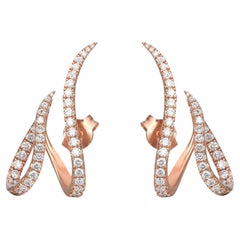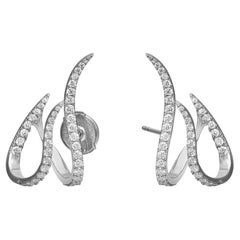Messika Daisy Earrings
2010s Modern Stud Earrings
Diamond, 18k Gold, Rose Gold
Recent Sales
2010s Modern Stud Earrings
Diamond, 18k Gold, White Gold
Messika for sale on 1stDibs
Messika is a contemporary French jewelry house, founded in 2005 in Paris by Valérie Messika, daughter of diamond merchant André Messika. The brand offers timeless and fashionable works of art that sit on the skin as naturally as a tattoo. Valérie Messika’s modern perspective on diamonds is that they should be celebrated daily, not reserved for special occasions, and give confidence to the women and men who wear them.
From a young age, Valérie was influenced by her father’s work. He would bring accessories home for her to play with and explain to her what made each piece of jewelry special and unique. He taught her how to see into the heart of a diamond, and as her dream of running her own design house grew, encouraged her to remain true to her vision and the legacy of the Messika name.
Messika jewelry is very much a family-run business, employing several family members as well as a largely female staff. The confidentially located atelier where the pieces evolve from concept to completion is a bright and modern space that evokes the powerful feminine energy Valérie Messika has infused into the work.
Messika's founder seeks to step into the unknown, breaking from traditional ideals while honoring the roots of the industry and creating a fresh and female-forward path for new industry leaders. While it is a young luxury house, it has still captured the attention of the celebrity spotlight.
American actress Mila Kunis wore Messika designs to the 94th Academy Awards. Venus Williams, Jennifer Lopez and Beyoncé have also chosen Messika jewelry for red-carpet events. Supermodel Kate Moss partnered with Messika to create the collaborative collection High Jewelry, which is flamboyant with lines that complement the feminine body, inspired by natural elements, Art Deco and bohemian style.
On 1stDibs, find a selection of Messika bracelets, rings, necklaces and more.
A Close Look at Modern Jewelry
Rooted in centuries of history of adornment dating back to the ancient world, modern jewelry reimagines traditional techniques, forms and materials for expressive new pieces. As opposed to contemporary jewelry, which responds to the moment in which it was created, modern jewelry often describes designs from the 20th to 21st centuries that reflect movements and trends in visual culture.
Modern jewelry emerged from the 19th-century shift away from jewelry indicating rank or social status. The Industrial Revolution allowed machine-made jewelry using electric gold plating, metal alloys and imitation stones, making beautiful jewelry widely accessible. Although mass production deemphasized the materials of the jewelry, the vision of the designer remained important, something that would be furthered in the 1960s with what’s known as the “critique of preciousness.”
A design fair called the “Exposition Internationale des Arts Décoratifs et Industriels Modernes” brought global attention to the Art Deco style in 1925 and gathered a mix of jewelry artists alongside master jewelers like Van Cleef & Arpels, Mauboussin and Boucheron. Art Deco designs from Cartier and Van Cleef & Arpels unconventionally mixed gemstones like placing rock crystals next to diamonds while borrowing motifs from eclectic sources including Asian lacquer and Persian carpets. Among Cartier’s foremost design preoccupations at the time were high-contrast color combinations and crisp, geometric forms and patterns. In the early 20th century, modernist jewelers like Margaret De Patta and artists such as Alexander Calder — who is better known for his kinetic sculptures than his provocative jewelry — explored sculptural metalwork in which geometric shapes and lines were preferred over elaborate ornamentation.
Many of the innovations in modern jewelry were propelled by women designers such as Wendy Ramshaw, who used paper to craft her accessories in the 1960s. During the 1970s, Elsa Peretti created day-to-night pieces for Tiffany & Co. while designers like Lea Stein experimented with layering plastic, a material that had been employed in jewelry since the mid-19th century and had expanded into Bakelite, acrylics and other unique materials.
Find a collection of modern watches, bracelets, engagement rings, necklaces, earrings and other jewelry on 1stDibs.
The Legacy of Diamond in Jewelry Design
Antique diamond rings, diamond tiaras and dazzling vintage diamond earrings are on the wish lists of every lover of fine jewelry. And diamonds and diamond jewelry are primarily associated with storybook engagements and red-carpet grand entrances — indeed, this ultra-cherished gemstone has a dramatic history on its hands.
From “A Diamond Is Forever” to “Diamonds Are a Girl’s Best Friend,” pop culture has ingrained in our minds that diamonds are the most desired, the most lasting and the most valuable gemstone. But what makes the diamond so special? Each stone — whether it’s rubies, sapphires or another stone — is unique and important in its own right. April babies might claim diamonds for themselves, but just about everyone wants this kind of sparkle in their lives!
There are several factors that set diamonds apart from other stones, and these points are important to our gem education.
Diamonds are minerals. They are made up of almost entirely of carbon (carbon comprises 99.95 percent; the remainder consists of various trace elements). Diamonds are the hardest gemstones, ranking number 10 on the Mohs Hardness Scale. Even its name, diamond, is rooted in the Greek adamas, or unconquerable. The only object that can scratch a diamond is another diamond. Diamonds are formed deep within the earth at very high temperatures (1,652–2,372 degrees Fahrenheit at depths between 90 and 120 miles beneath the earth’s surface) and are carried up by volcanic activity. Diamonds are quite rare, according to the Gemological Institute of America, and only 30 percent of all the diamonds mined in the world are gem quality.
In the 1950s, the Gemological Institute of America developed the 4Cs grading system to classify diamonds: clarity, color, cut and carat weight. Not all diamonds are created equal (there are diamonds, and then there are diamonds). The value of the diamond depends on the clarity (flawless diamonds are very rare but a diamond's value decreases if there are many blemishes or inclusions), color (the less color the higher the grade), cut (how the diamond’s facets catch the light, certain cuts of diamonds show off the stone better than others) and carat weight (the bigger, the better).
When you start shopping for a diamond engagement ring, always prioritize the cut, which plays the largest role in the diamond's beauty (taking the time to clean your diamond ring at least every six months or so plays a role in maintaining said beauty). And on 1stDibs, a range of buying guides can be found for those in the market for antique engagement rings, vintage engagement rings or Art Deco engagement rings.
Shop antique and vintage diamond rings, diamond necklaces and other extraordinary diamond jewelry on 1stDibs.
Finding the Right Stud-earrings for You
Stud earrings have a unique and rich cultural history. Though their design has evolved, vintage stud earrings are still a classic jewelry style.
Stud earrings are frequently dated back over 7,000 years to Asia, where they were worn mostly by upper-class men to indicate their wealth and status. Although earrings sometimes fell out of favor over the years — such as when ear piercing was prohibited by the Catholic Church in the 13th century — they’ve remained one of the most enduring forms of body modification.
When diamond jewelry gained prominence in the 19th century, thanks to prosperity in Europe and the United States as well as the greater accessibility of gemstones, studs adorned with fine diamonds became popular. Screw-back earrings debuted in the late 19th century and allowed people without pierced ears to don the embellishment. Stud earrings became especially popular in the 1960s.
Stud earrings are simple and usually small in size, making them lightweight and easy to wear. Unlike other earrings, stud earrings have a floating appearance. They are often made with a single gemstone, such as a sapphire or emerald, and a straight post that goes through the ear, typically with a rubber or metal backing to hold it in place.
Today, stud earrings accentuate outfits with a casual, elegant style, adding a bit of glam to any ensemble. Find an eclectic array of stud earrings on 1stDibs.

